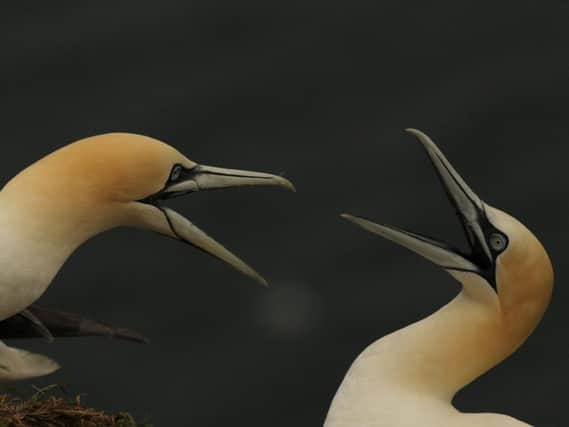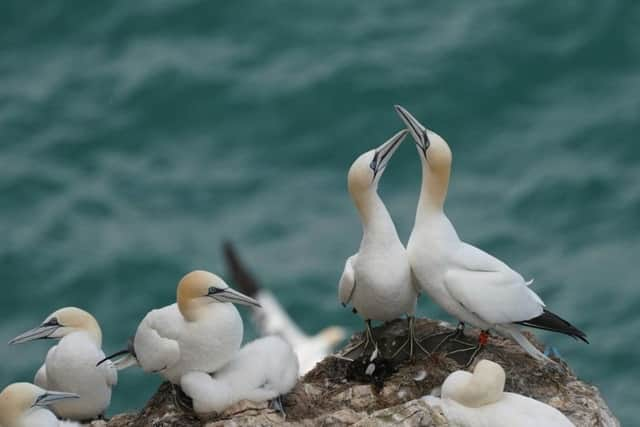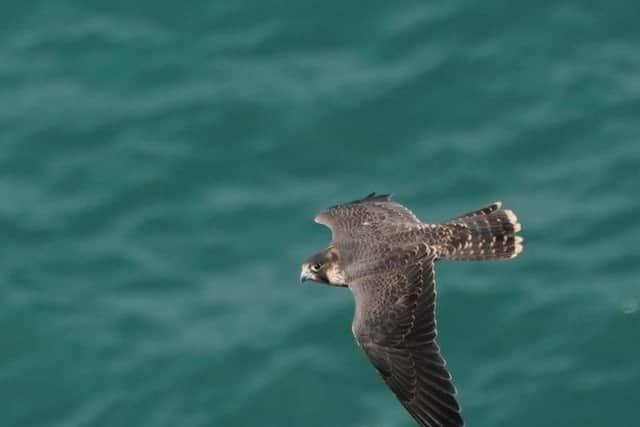Robert Fuller studies one of the most spectacular wildlife sights in Yorkshire at Bempton Cliffs


So when some friends came to stay for a weekend in July and offered to carry my cameras for me, I was off!
We went to RSPB Bempton Cliffs, a nature reserve on the east coast that is host to some of Yorkshire’s largest sea bird colonies.
Advertisement
Hide AdAdvertisement
Hide AdA year doesn’t seem complete without visiting this wildlife Mecca. The last time I was there it was winter and the seabirds that cling to these steep chalk cliffs in the summer were all out at sea. Although the cliffs were still a spectacular sight, back then they looked bare; like a deserted city.


This time I could smell the sea bird colony as soon as I got out of my car. As I walked towards the cliffs, I could hear and see birds riding on updrafts.
But it wasn’t until I reached the edge that I was greeted with one of the most spectacular sights in Yorkshire. Tens of thousands of nesting sea birds cling to these 300ft-high cliffs each summer.
Their huddled forms create patterns on the cliff-face as they group amongst their own type. Following the strata of the rock, were lines of different bird species; all sitting on precarious nests. Guillemots and razorbills settled on the smaller ledges. The larger ledges were occupied by gannets and noisy kittiwakes, tending to their super cute fluffy-grey chicks.
Advertisement
Hide AdAdvertisement
Hide AdThe air was filled with a myriad of swirling birds. Fulmars, gannets, guillemots, razorbills, kittiwakes and, the birds everyone comes to Bempton to see: puffins.


These clowns of the sea have colourful bills and legs – and eyes that look as if they’ve been made-up. As I watched one came flying in to the cliff face, wings whirring, and disappeared into a crevice in the rock face where it had a single chick on a nest waiting for a meal.
These birds are true seafarers. They spend most of the year out at sea and only come ashore to breed. They choose steep cliffs like Bempton in the hope that their chicks will be safe.
Advertisement
Hide AdAdvertisement
Hide AdBut actually they are only relatively so, because 50 yards on from the puffin nest I had just spotted, was a young male peregrine perched on the cliff.
I watched this falcon for a while as it preened and stretched, and then I heard an adult calling. A female peregrine was flying along the cliff edge. As she flew past, the chick looked up at her and called out hoping its mother would deliver a meal. But the adult landed round the corner, just out of sight.
I walked on to my favourite viewpoint, Staple Newick, at the southern end of the reserve. Here the rock juts out into the sea forming a chalk arch. This church of rock is covered with gannets.
Gannets are stunning birds. Pure white with black aerodynamic wing tips, soft yellow heads, striking blue-grey dagger-like beaks edged with black and piercing grey-blue eyes, they are an artist’s dream.
Advertisement
Hide AdAdvertisement
Hide AdBempton is host to the UK’s largest mainland colony of gannets. With more than 11,000 breeding pairs nesting along its cliffs every summer, it is hard not to feel overwhelmed.
From a photographer’s perspective, it’s difficult to know which way to look. I like to focus on just one area and let the drama play out. It’s the only way to decipher individual stories.
I spent the next four hours just looking and filming an area of gannets. As I watched them come and go from their nests with food and nesting materials I began to be able to pick out individual birds.
Advertisement
Hide AdAdvertisement
Hide AdGannets are the UK’s largest sea birds and it is fascinating to watch as they dive into the sea at dizzying speeds.
They have air sacs in their face and chest to cushion the impact as they plunge into the water, much like bubble wrap would protect the impact of a fall.
They also have binocular vision, which helps them to judge distances accurately as they continue to pursue fish underwater.
Advertisement
Hide AdAdvertisement
Hide AdGannet nests are tightly-packed and set just pecking distance apart, so squabbles between neighbours are common. I watched a female gannet struggling to land on its nest. Its mate was dozing alongside their large downy chick and there was no room.
On the third attempt the female crash landed, which, with a six-foot wingspan, was a less than graceful manoeuvre to say the least.
Startled from its slumber, the male gannet lashed out instinctively and grabbed the poor female by her neck, pinning her to the ground with his beak.
The neighbours joined in the fracas, snatching at the poor female gannet’s wing. It wasn’t until the besieged bird called out in protest, that its mate realised his mistake.
Advertisement
Hide AdAdvertisement
Hide AdHe immediately released his grip on her neck and she turned round to peck him, as if telling him off. Then they both turned on their neighbours.
When all had settled down, the male and female started over and greeted one another in far more formal fashion. It was as if nothing had happened.
This gannet greeting was beautiful to watch. Both birds pointed their beaks skywards, then shook their head from side to side and rubbed their beaks together whilst calling out.
As if the drama offered by this stunning gannet courtship display wasn’t enough, a peregrine then put on its own stunning air show.
Advertisement
Hide AdAdvertisement
Hide AdIt tail-chased herring gulls and gannets across the sea with such style it was obvious it was having fun and showing off rather than hunting.
I watched it suddenly leave the herring gulls and punch upwards, using the updraft of the cliff to gain height, before stooping back down again, this time to harass a jackdaw.
Then there was a rush of wings as it passed right over our heads. What a great end to a magical day. I was so pleased to be out amongst the action, after three weeks of home rest I realised I had been suffering from cabin-fever.